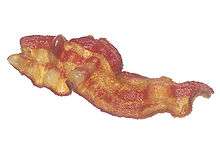Tocino


Tocino is bacon in Spanish, typically made from the pork belly and often formed into cubes in Spain. A variant of it is popular in the Philippines. In Caribbean countries, meanwhile, such as Puerto Rico and Cuba, tocino is made from pork fatback (equivalent to the slab bacon cut in the United States) and is neither cured nor smoked but simply fried until very crunchy; it is then added to recipes, much like the way lardons are used in French cuisine.
Philippines
In making tocino in the Philippines, the pork belly meat is first sliced into thin strips. Anise wine, annatto, water, sugar, and salt are then combined in a container to make a mixture. Each of the meat strips is then sprinkled with the mixture and then stacked in a separate container, which is then covered and kept refrigerated for about three days to cure.
Tocino is traditionally boiled in water (just enough to cover the meat) or fried in oil, or is cooked over medium heat until the fat is rendered. The original tocino is marinated only with salt, sugar, and salitre (saltpetre), although pineapple juice may be added for a slightly tart flavor. The Kapampangans who make tocino mix it for four to six hours in order to achieve thickness and softness in the meat, then leave it overnight at room temperature before serving it as burong babi (fermented pork).
Tocino is often served as the popular breakfast or lunchtime combination called Tosilog, which name is a portmanteau of tocino, sinangág (garlic rice) and itlóg (egg, which is cooked either sunny-side up or scrambled).
Caribbean
Tocino is cut into small squares and fried until crunchy and added to recipes like mofongo and arroz blanco con tocino, "White rice and Tocino". In Cuba, it can be added to soft bread.
Spain
In Spain, as in Venezuela (where bacon is "tocineta") the word tocino refers to the layer of fat under a pig's skin. It is almost pure fat, and is often salted and cut into cubes. It is consumed as part of traditional recipes such as Cocido.
See also
References
External links
- Filipino Pork Tocino Recipe
- Tocino de Pancetta, Pancia
- Panceta de Cerdo
- Tocino Puerto Rico
